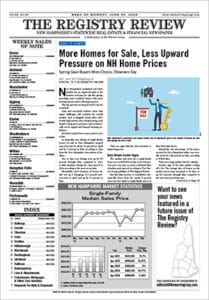
Once a staple, some banks are choosing to close supermarket-based branches rendered unprofitable by persistently low margin spreads as customers increase their use of online transaction services.
New England will lose dozens of bank branches in the next couple of years as several lenders shutter locations inside supermarkets, as persistently small margin spreads make these locations unprofitable.
With the pandemic keeping many customers away from branches and accelerating the adoption of online and mobile banking, more branches could close as banks adapt to changes in consumer behaviors. And if merger activity picks up as lenders consider their post-pandemic options, branch consolidations could follow.
But even as some lenders branches close locations, branches remain important to customers, and some banks are using them as a cornerstone of expansion plans.
“There may be a time when having a branch in town just doesn’t matter, but today is not that day,” said Jeff Marsico, president of the Pennsylvania-based consulting firm The Kafafian Group. “Individuals and small businesses still rate as the highest reason they select a bank is because of its location.”
Unprofitable Locations Culled
One problem banks face is the ongoing low interest rate environment and the profitability of their branch deposits.
“When the low end of the yield curve is zero, the spread that banks could derive through deposits is low,” Marsico said. “In fact, many deposit products are unprofitable right now.”
The latest branch casualties include Stop & Shop locations. Citizens Bank announced plans in the fall to close 40 Stop & Shop branches in Massachusetts and Rhode Island, including 26 closing in Massachusetts this year. People’s United Bank announced in January that it would start in 2022 to close all of its 140 Stop & Shop branches in Connecticut and New York.
Locating branches inside supermarkets – with their built-in foot traffic – peaked in the 1990s, Marsico said. Around that same time banks began to see a shift in branches from primarily transactional activity to also include consultative interactions.
“People considered in-store branches just as a place to cash a check, do a transaction,” Marsico said. “They never really took it seriously, from my experience, as some place to go and sit down and talk about their goals and objectives and map a plan, learn how to do proper budgeting … while people were walking by shopping for milk.”
These branches were plagued by low deposits, limiting the revenue that could be generated from the spread on those deposits, Marsico said. Supermarket branches have persisted because lower operating expenses at these locations often offset the reduced revenue, he added.
Now these branches have also been affected by shifts in retail behavior, which have accelerated during the pandemic. Many shoppers have been making orders online for delivery or pickup, diminishing the traffic coming to those branches, Marsico said.
Stop & Shop is not the only retail chain losing branches. Boston-based, $12.6 billion-asset Berkshire Bank announced in December plans to reduce its footprint by 18 percent by closing branches in Massachusetts, Connecticut and New York while selling its Mid-Atlantic branches. The announced closings so far have included two Connecticut branches in Walmart stores.
While diminished, supermarket branches still have a place in banking. Citizens plans to keep many of its Shop & Stop branches, and said in a statement it will retain ATM kiosks at the closed branches and install virtual teller machines at some locations. People’s United said it continues to negotiate a contract with Stop & Shop.
Digital Shift Evident
During People’s United’s conference call to discuss fourth quarter earnings, CEO Jack Barnes pointed to the shifts in retail behaviors as well as the acceleration of online and mobile banking as reasons for closing branches.
Barnes said customers of the Stop & Shop branches were 13 percent more digitally active than other customers, with only 10 percent of deposit balances associated with Stop & Shop branch customers who did not use a digital channel in 2020.
“Although our Stop & Shop relationship has provided meaningful value to the bank and its customers over more than two decades, this decision provides us the opportunity to further optimize our branch network while providing the same level of personalized service across each of our channels,” Barnes said.
In a report released last month called “The Front-to-Back Digital Retail Bank,” Boston Consulting Group found that 15 percent of survey respondents in the U.S. had enrolled in online banking for the first time during the pandemic, while 13 percent of U.S. respondents had enrolled in mobile banking for the first time.
Across the globe, BCG said survey results show a 12 percent reduction in branch visits, which is expected to reduce further by 26 percent after the pandemic.
Still, many banks remain committed to branch networks. Bangor Savings Bank, NBT Bank, Bar Harbor Bank & Trust, Northway Bank, St. Mary’s Bank and Align Credit Union all filed plans with state regulators in the last year to open branches in the state, from Seabrook to Concord.

